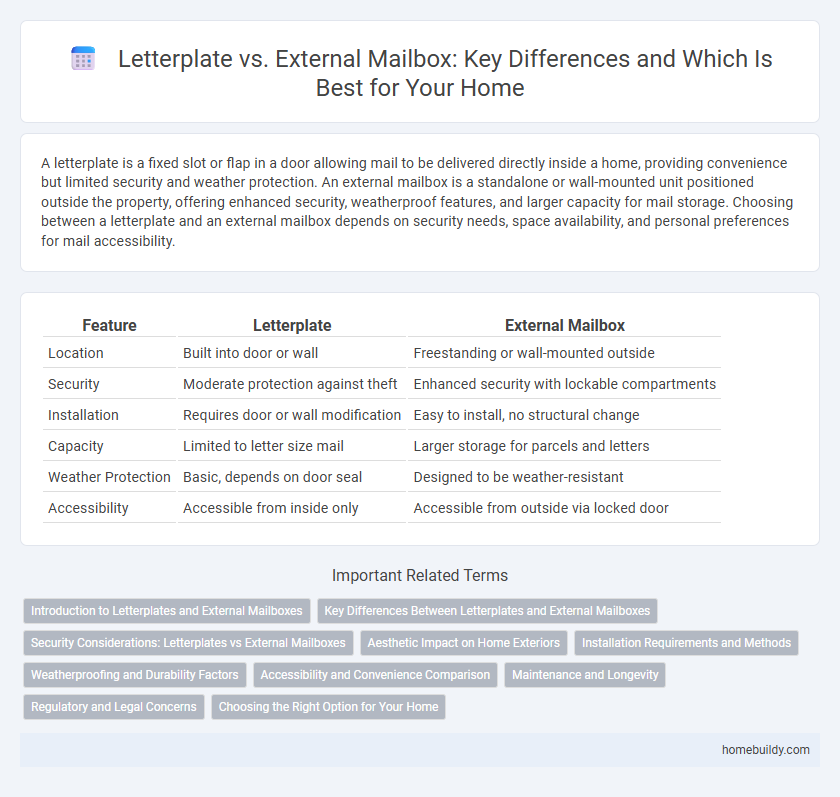A letterplate is a fixed slot or flap in a door allowing mail to be delivered directly inside a home, providing convenience but limited security and weather protection. An external mailbox is a standalone or wall-mounted unit positioned outside the property, offering enhanced security, weatherproof features, and larger capacity for mail storage. Choosing between a letterplate and an external mailbox depends on security needs, space availability, and personal preferences for mail accessibility.
Table of Comparison
| Feature | Letterplate | External Mailbox |
|---|---|---|
| Location | Built into door or wall | Freestanding or wall-mounted outside |
| Security | Moderate protection against theft | Enhanced security with lockable compartments |
| Installation | Requires door or wall modification | Easy to install, no structural change |
| Capacity | Limited to letter size mail | Larger storage for parcels and letters |
| Weather Protection | Basic, depends on door seal | Designed to be weather-resistant |
| Accessibility | Accessible from inside only | Accessible from outside via locked door |
Introduction to Letterplates and External Mailboxes
Letterplates are integrated into doors or walls, enabling mail insertion directly into a property, providing convenience and security. External mailboxes, mounted outside the building, offer standalone mail storage accessible by residents without opening the door. Both options serve as essential mail collection solutions with distinct placement and accessibility features tailored to different property needs.
Key Differences Between Letterplates and External Mailboxes
Letterplates are integrated into a door or wall, offering a discreet and weather-protected slot for mail delivery, while external mailboxes are standalone units mounted outside the property. Letterplates enable mail to be deposited directly into the home, enhancing convenience but potentially reducing security, whereas external mailboxes provide secure, lockable storage that safeguards mail from theft and environmental damage. The choice between letterplates and external mailboxes depends on factors like property design, security needs, and local postal regulations.
Security Considerations: Letterplates vs External Mailboxes
Letterplates provide a secure, integrated entry point for mail delivery directly into buildings, minimizing exposure to theft compared to external mailboxes that are more vulnerable to tampering and vandalism. External mailboxes often lack robust locking mechanisms and can be easily accessed by unauthorized individuals, increasing the risk of mail theft and identity fraud. Advanced letterplates with security features like reinforced flaps and internal compartments enhance protection by preventing unauthorized retrieval and weather damage.
Aesthetic Impact on Home Exteriors
Letterplates integrate seamlessly into the door, maintaining a sleek and unobtrusive aesthetic that preserves the clean lines of home exteriors. External mailboxes, often bulky and protruding, can disrupt the facade's visual harmony and appear less refined. Homeowners seeking to enhance curb appeal frequently prefer letterplates for their minimalist and elegant design.
Installation Requirements and Methods
Letterplates require installation directly into the door or wall, necessitating precise cutting and alignment to ensure secure fit and weatherproof sealing. External mailboxes are mounted on walls or posts, allowing more flexible placement but often requiring additional anchors or brackets for stability. While letterplate installation demands integration with door structure, external mailbox setup typically involves surface mounting with less structural modification.
Weatherproofing and Durability Factors
Letterplates provide superior weatherproofing by being integrated directly into the door, minimizing exposure to rain, wind, and dust compared to external mailboxes, which are more vulnerable to environmental elements. The durable materials used in letterplates, such as stainless steel or reinforced aluminum, enhance longevity and resistance to corrosion, unlike many external mailboxes that may suffer from rust or damage due to prolonged outdoor exposure. Proper installation of a letterplate ensures a tighter seal and better protection for mail, making it a more reliable choice in harsh weather conditions.
Accessibility and Convenience Comparison
Letterplates provide direct mail delivery through the door, enhancing accessibility by allowing recipients to collect mail without stepping outside. External mailboxes, while often larger and capable of holding more mail, require users to go outside, potentially impacting convenience in adverse weather. The choice between letterplate and external mailbox hinges on balancing immediate indoor access against storage capacity for mail.
Maintenance and Longevity
Letterplates require minimal maintenance due to their integration within the door, reducing exposure to weather elements that typically cause wear. External mailboxes, often made of metal or plastic, need regular upkeep to prevent rust, fading, or damage from environmental factors. The longevity of letterplates generally surpasses external mailboxes as they are less susceptible to corrosion and physical damage over time.
Regulatory and Legal Concerns
Letterplates comply with building regulations and fire safety codes more easily than external mailboxes, which often require additional permits and adherence to local zoning laws. Legal concerns surrounding letterplates include privacy and security standards, as they are integrated into doors, limiting unauthorized access risks compared to standalone external mailboxes vulnerable to theft. Regulatory compliance for letterplates typically involves meeting specific size and placement criteria dictated by postal services to ensure mail delivery efficiency and security.
Choosing the Right Option for Your Home
Letterplates provide a sleek, integrated solution for home mail delivery, offering convenience and security while maintaining the aesthetic of your front door. External mailboxes offer greater capacity and easier access for bulkier parcels, especially suitable for homes expecting frequent or larger deliveries. Selecting between a letterplate and an external mailbox depends on your parcel volume, security needs, and the architectural style of your residence.
Letterplate vs External Mailbox Infographic

 homebuildy.com
homebuildy.com